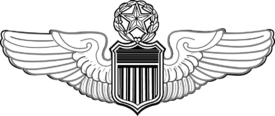Thomas D. White
| Thomas D. White | |
|---|---|
 US Air Force Photo | |
| Nickname(s) | Tom |
| Born |
August 6, 1901 Walker, Minnesota |
| Died |
December 22, 1965 (aged 64) Walter Reed Army Medical Center, Washington D.C. |
| Allegiance | United States |
| Service/ |
United States Air Force United States Army |
| Years of service | 1920–1961 |
| Rank | General |
| Commands held |
Chief of Staff of the United States Air Force Fifth Air Force Seventh Air Force |
| Battles/wars |
World War II Korean War |
| Awards |
Army Distinguished Service Medal (2) Legion of Merit (2) Air Medal (2) |
General Thomas Dresser White (August 6, 1901 – December 22, 1965) was the fourth Chief of Staff of the United States Air Force.
Life and career
White was born in Walker, Minnesota, on August 6, 1901. Upon graduation from the United States Military Academy on July 2, 1920, he was commissioned a second lieutenant of Infantry and immediately promoted to first lieutenant.
Entering the Infantry School at Fort Benning, Georgia, White graduated in July 1921, and was assigned duty with the 14th Infantry Regiment at Fort Davis, Panama Canal Zone.
In September 1924, he entered Primary Flying School at Brooks Field, Texas. He graduated from Advanced Flying School at Kelly Field, Texas, in September 1925, and was assigned duty with the 99th Observation Squadron at Bolling Field, Washington, D.C..
In June 1927, White was assigned to duty as a student of the Chinese language in Peking, China. Four years later, he returned to the United States for duty at Headquarters Air Corps, Washington, D.C.
White was named assistant military attache for air to Russia in February 1934. A year later, he was appointed assistant military attache for air to Italy and Greece, with station at Rome.
White graduated from the Air Corps Tactical School at Maxwell Field, Alabama, in May 1938. He then entered Command and General Staff School at Fort Leavenworth, Kansas. Upon completion of this training, he was assigned to the Office of the Chief of Air Corps, Washington, D.C.
In April 1940, White became military attache to Brazil and the following August was named chief of the U.S. Military Air Mission to Brazil.
Returning to the United States in March 1942, White was appointed assistant chief of staff for operations of the Third Air Force at MacDill Field, Tampa, Florida, and subsequently named chief of staff.
Reassigned to Air Force Headquarters in January 1944, he became assistant chief of air staff for intelligence.
Proceeding to the Southwest Pacific in September 1944, White assumed duty as the deputy commander of the Thirteenth Air Force, taking part in the New Guinea, Southern Philippines and Borneo campaigns. The following June, he assumed command of the Seventh Air Force in the Marianas and immediately moved with it to Okinawa. In January 1946, he returned with the Seventh Air Force to Hawaii. That October, he was appointed chief of staff of the Pacific Air Command in Tokyo, Japan. One year later, in October 1947, White took command of the Fifth Air Force in Japan.
Transferred to the Office of the Secretary of the Air Force in October 1948, White became director of the Legislation and Liaison. He was appointed, in May 1950, Air Force Member of the Joint Strategic Survey Committee in the Office of the Joint Chiefs of Staff. He was assigned as director of Plans, Headquarters U.S. Air Force, in February 1951, and in July 1951, assumed duties of deputy chief of staff of operations for the Air Force.
White was promoted to the rank of general on June 30, 1953, and designated Vice Chief of Staff of the United States Air Force at that time, becoming Chief of Staff of the United States Air Force on July 1, 1957. He retired June 30, 1961.
Awards and decorations
 |
US Air Force Command Pilot Badge |
| Army Distinguished Service Medal with one bronze oak leaf cluster | |
| Legion of Merit with oak leaf cluster | |
| Air Medal with oak leaf cluster | |
| Army Commendation Medal with oak leaf cluster | |
| World War I Victory Medal | |
| Marine Corps Expeditionary Medal | |
| American Defense Service Medal with one bronze service star | |
| American Campaign Medal | |
| Asiatic-Pacific Campaign Medal with Arrowhead device and four service stars | |
| World War II Victory Medal | |
| Army of Occupation Medal | |
| National Defense Service Medal with service star | |
| Korean Service Medal | |
| Air Force Longevity Service Award with silver and three bronze oak leaf clusters | |
| Air Force Longevity Service Award | |
| Philippine Liberation Medal with service star | |
| Philippine Independence Medal | |
| United Nations Korea Medal | |
| Order of the British Empire, Military version | |
| Order of Merit of the Italian Republic, Knight Grand Cross | |
| Order of the Southern Cross, Grand Officer (Brazil) | |
| Order of the Rising Sun, grade unknown (Japan) |
- White received at least three more foreign decorations.
He died on December 22, 1965 of leukemia and is buried at Arlington National Cemetery.
References
| Wikimedia Commons has media related to Thomas D. White. |
- Official USAF biography at Archive.is (archived 2012-12-12)
- Thomas Dresser White Papers at Syracuse University
| Military offices | ||
|---|---|---|
| Preceded by Nathan F. Twining |
Vice Chief of Staff of the United States Air Force 1953–1957 |
Succeeded by Curtis E. LeMay |
| Chief of Staff of the United States Air Force 1957–1961 | ||
